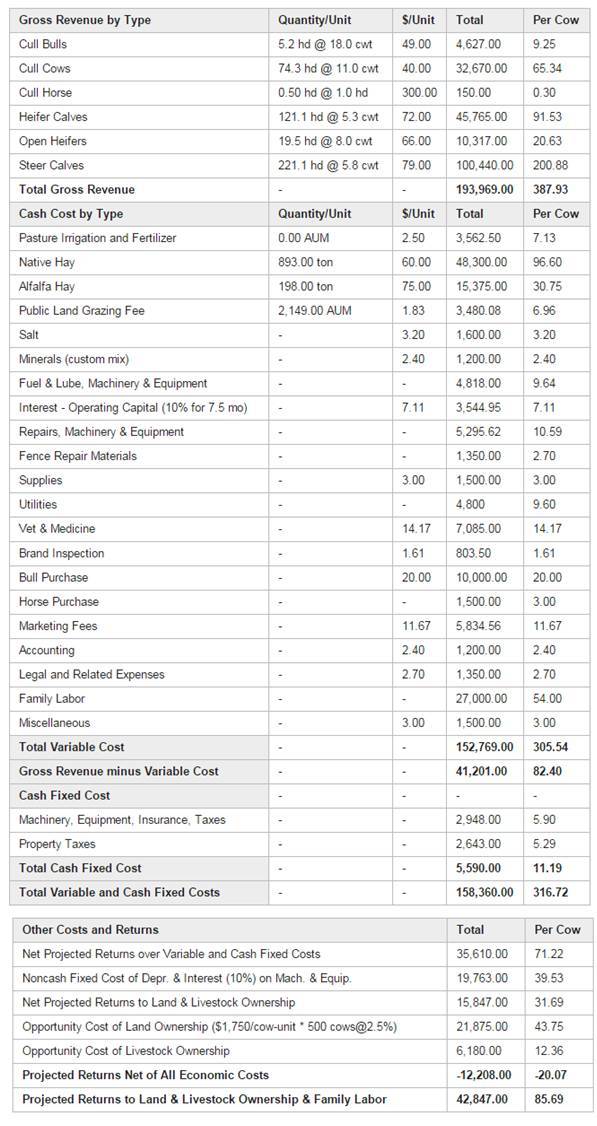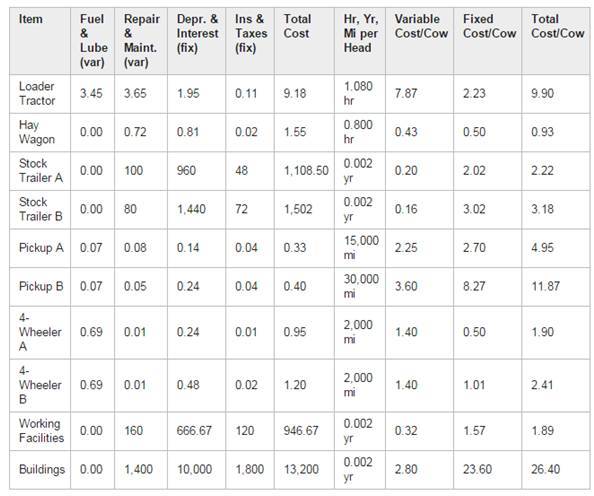Written by John Tanaka, University of Wyoming
Grazing by domestic livestock -- that is, cattle, sheep, and goats -- is one of the most widespread uses of rangelands. Deciding what species to graze, how to graze them, how many to graze, and where and when to graze has been the subject of much rangeland research and management. Economic analysis can help the decision-maker determine answers to those questions when he or she wants to know the profit maximizing levels.
The basic economic principle being applied is to equate the value of the marginal product to the marginal factor costs. In essence, this says that the last animal added to the herd should produce just enough income to cover the cost of producing it. With the law of diminishing returns, each animal added contributes less to profit than did the previous one and at the economically optimal stocking rate, the last animal adds nothing to profit. Stocking rate and varying stocking rate to match forage conditions have emerged as the most important factors influencing ranch profitability and the economic responses to grazing.
Grazing systems have been developed through the years to assist in the management of livestock and to improve the health of the land. If the system is going to be economically beneficial, either animal performance or forage production must improve over time. In addition, a grazing system could result in lower operating costs, may reduce fire danger due to removal of vegetation, or provide other habitat improvements that society values.
Economic Feasibility of Range Improvement Practices - Rangeland improvement practices are implemented for a variety of reasons. Historically, they were done primarily for managing livestock like cattle and sheep. As other uses of the rangelands became more important, managers began designing them for use by wildlife, to avoid impacts on wildlife and recreationists, to reduce soil erosion, to improve riparian areas, and many other reasons. Each of these uses causes different benefits and incurs different costs. The economic analysis of any such project is the same.
The economic analysis of any project requires that one estimate both the costs and the benefits from the project through time. Costs include both the initial investment and the annual maintenance and repairs. Benefits include all of the annual returns upon which society places value. The life of the project will also be an important consideration. A problem arises when not all of the costs or benefits can be quantified or valued.
Estimating Costs - Costs include the initial investment and annual maintenance and repairs. Projects can be designed in a variety of ways, each affecting both types of costs and the project life. A reasonable variety of project designs can be developed to achieve the management goals. Each design can have its costs estimated.
For example, if the manager decides to remove a woody plant species to increase the amount of forage available for cattle, there are many ways to achieve that goal, including using herbicides, prescribed fire, mechanical removal, and biological control. Each of these methods can be applied at different intensities with different success rates and risks. Different herbicides can be applied using ground or aerial application methods, at different rates, and in different patterns with different levels of brush kill and different levels of plant responses.
The manager must weigh all of these factors in deciding on the methods to use for a particular project. In many areas, there will be a desired method to implement based on experience. That should not preclude the evaluation of alternatives based on changing sets of goals to be achieved.
Estimating Benefits - Benefits from rangeland improvement practices can be more difficult to estimate. Benefits from livestock forage produced are relatively straightforward, while those related to scenic views and wildlife may be harder.
If the benefit is from livestock forage, it can be valued by either considering the cost of alternative feeds such as hay or leased pastures. The process is to estimate how much additional forage will be produced by the practice and apply one of those values to it to come up with a total value.
If the project is expected to result in nonmarket benefits such as reduced soil erosion, increased streamflow, wildlife habitat, scenic views, or recreational opportunities, the benefit estimation is much more difficult. Basically three methods can be used in these cases: travel cost method, contingent valuation method, and avoided costs.
The travel cost method (TCM) can be used if there is a specific location people travel to do something. It is primarily used for recreation sites where people go to an area to hunt, fish, swim, boat, view scenery, or enjoy other such activities.
The contingent valuation method (CVM) is used when the item or use being valued is not necessarily based on a location. In essence, the method seeks to ask a cross section of people what they would be willing to pay for some changed condition or situation. The responses are then used to come up with an estimate of value.
The avoided cost method would be used if the project were to reduce costs incurred before the project was implemented. If reduced soil erosion resulted in less water treatment or reduced the need to dredge behind dams, those reduced costs can be considered a benefit of the project.
Each of these nonmarket valuation methods has been used for a variety of uses of rangelands. While there are concerns about their validity for use in planning and management, each method can provide relative values that could be used in project analysis. Care must be applied in both how the methods are applied and how the resulting estimates are used.
Feasibility Analysis - Once the costs and benefits are estimated, three basic methods are used to estimate economic feasibility:
With three methods available, which is the best to use? All three methods use the same information. In the case of PNW and B/C, the analyst needs to know what discount rate to use in the calculations, whereas with the IRR, the analyst needs to know what interest rate to compare with the IRR. PNW is likely the best method to use (Workman 1981), although the others provide useful information as well.
See also: Workman, J. P. 1981. Disagreement among investment criteria - A solution to the problem. Journal of Range Management 34:319-324.
Internal Rate of Return (IRR)
The internal rate of return (IRR) is one measure used by economists to evaluate investments. It is based on the principal of discounting which is where future values are brought to present values based on some discount rate. The IRR method seeks to find that discount rate whereby the present value of future returns just equals the initial investment cost.
In rangeland management, many projects will have an initial cost that will create changes in future costs and returns to whatever operation is being considered. For example, seeding desirable grass and shrub species is an activity to restore degraded rangelands or to change the desired mix of vegetation on a particular range site. The process of removing undesirable vegetation, preparing the seedbed, and seeding the desirable plants entails an initial cost. The initial investment is expected to change the future income stream to the ranch by increasing forage, changing the season of forage availability, and/or changing herd management. If values are placed on each of the costs and returns, and the timing of each of those, an IRR can be calculated.
The decision rule is that if the IRR is greater than the rate of return that the decision-maker could earn on the use of those funds, then the project is considered to be economically feasible. Another way of looking at it is if the IRR is greater than what the decision-maker would have to pay in interest to finance the project, then it is economically feasible.
The IRR is one economic measure to help evaluate an investment. It can help a rangeland manager decide if the project will return enough to justify making the investment based on the cost of borrowing funds or an alternative investment rate -- for example, what you could earn in an alternative such as the stock market.
If you assume that the net annual returns from the initial investment are equal, then you can apply the following formula and seek to find the discount rate, either through trial and error or using set tables as described in Nielson (1977).
 I = Initial investment
I = Initial investment
R = Net additional annual return
r = Discount rate
i = Years of equal net annual returns.
If the net annual returns are not equal, you can use the formula for Present Net Worth and solve for Present Net Worth equal to zero.
For more information, see:
Nielsen, Darwin B. 1977. Economics of range improvements: a rancher's handbook to economic decision-making. Utah Agricultural Experiment Station Bulletin 466 (revised). Logan, Utah. 52 p.
Workman, John P. and John A. Tanaka. 1991. Economic feasibility and management considerations in range revegetation. Journal of Range Management 44(6):566-573.
Present Net Worth (PNW)
Present Net Worth (PNW) is used to determine if the benefits, or income, are greater than the costs when both are valued in current dollars. The method requires that future values are discounted to a present value and added together. The basic formula is:
 PNW = Present Net Worth
PNW = Present Net Worth
i = year being considered, generally 0 to N, where N is the last year of the planning horizon
Benefitsi = Benefits from the projects obtained in year i
Costs(i) = Costs from the projects obtained in year i. The initial investment in the project is assumed to occur in year 0.
r = the discount rate.
For more information, see:
Nielsen, Darwin B. 1977. Economics of range improvements: a rancher's handbook to economic decision-making. Utah Agricultural Experiment Station Bulletin 466 (revised). Logan, Utah. 52 p.
Workman, John P. and John A. Tanaka. 1991. Economic feasibility and management considerations in range revegetation. Journal of Range Management 44(6):566-573.
Benefit-Cost Ratio (B/C)
Written by John Tanaka, University of Wyoming
The benefit-cost ratio (B/C) is used to compare the present value of all benefits to the present value of all costs. The ratio is merely used to see if a $1 of costs will return at least $1 in benefits.
B/C is used by many federal agencies in the economic justification of projects. The discount rate is set by policy and is generally used at 3, 7, and 10% (or some other range) to see how sensitive the results are to the discount rate. In addition, the agencies have attempted to include nonmarket benefits and costs (i.e., goods and services for which there is no market price) in its calculation.
The basic formula for the B/C ratio is:
 B/C = Benefit-Cost Ratio
B/C = Benefit-Cost Ratio
i = year being considered, generally 0 to N, where N is the last year of the planning horizon
Benefitsi = Benefits from the projects obtained in year i
Costsi = Costs from the projects obtained in year i. The initial investment in the project is assumed to occur in year 0.
r = the discount rate.
 I = Initial investment
I = Initial investment PNW = Present Net Worth
PNW = Present Net Worth B/C = Benefit-Cost Ratio
B/C = Benefit-Cost Ratio





